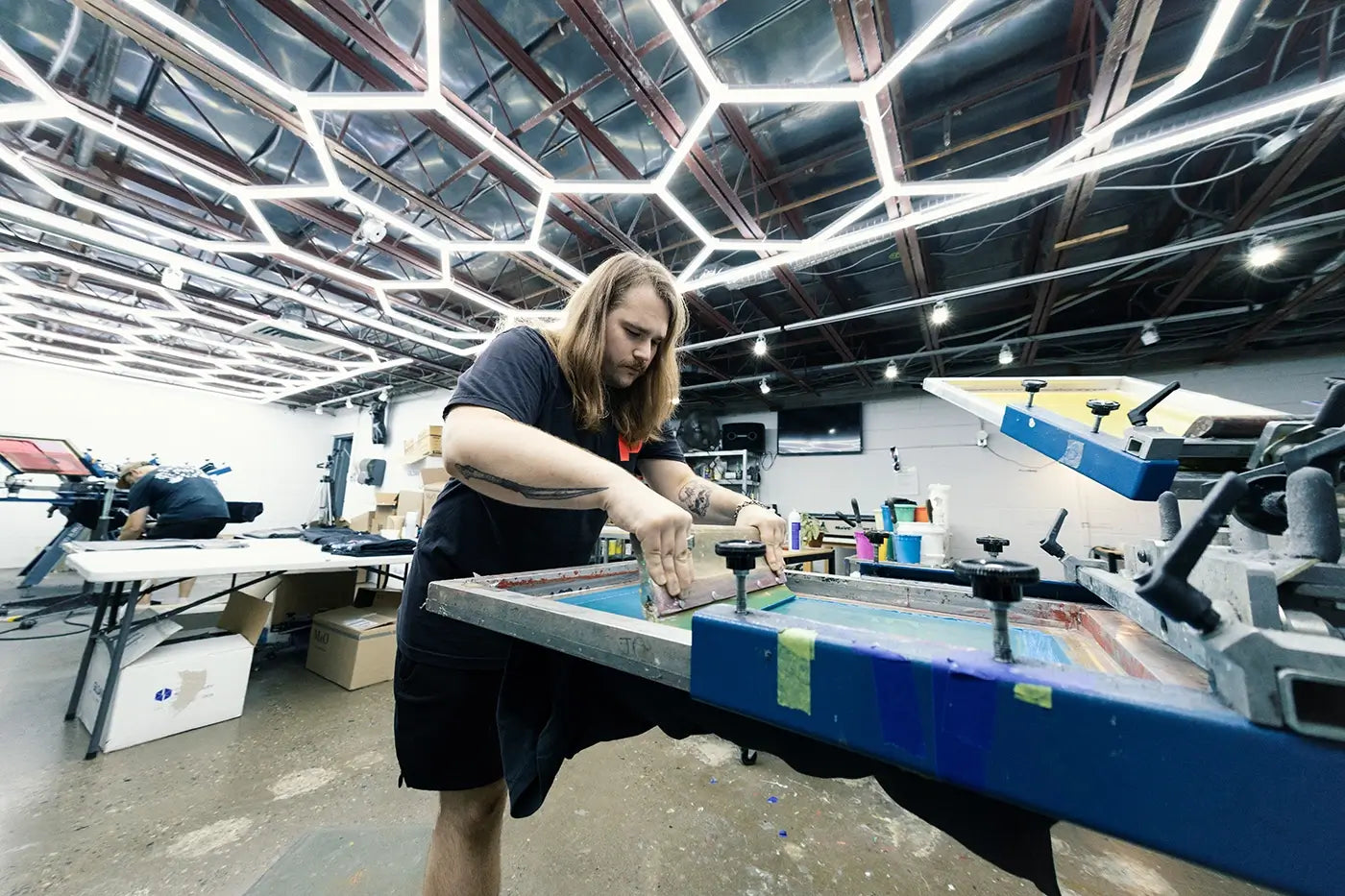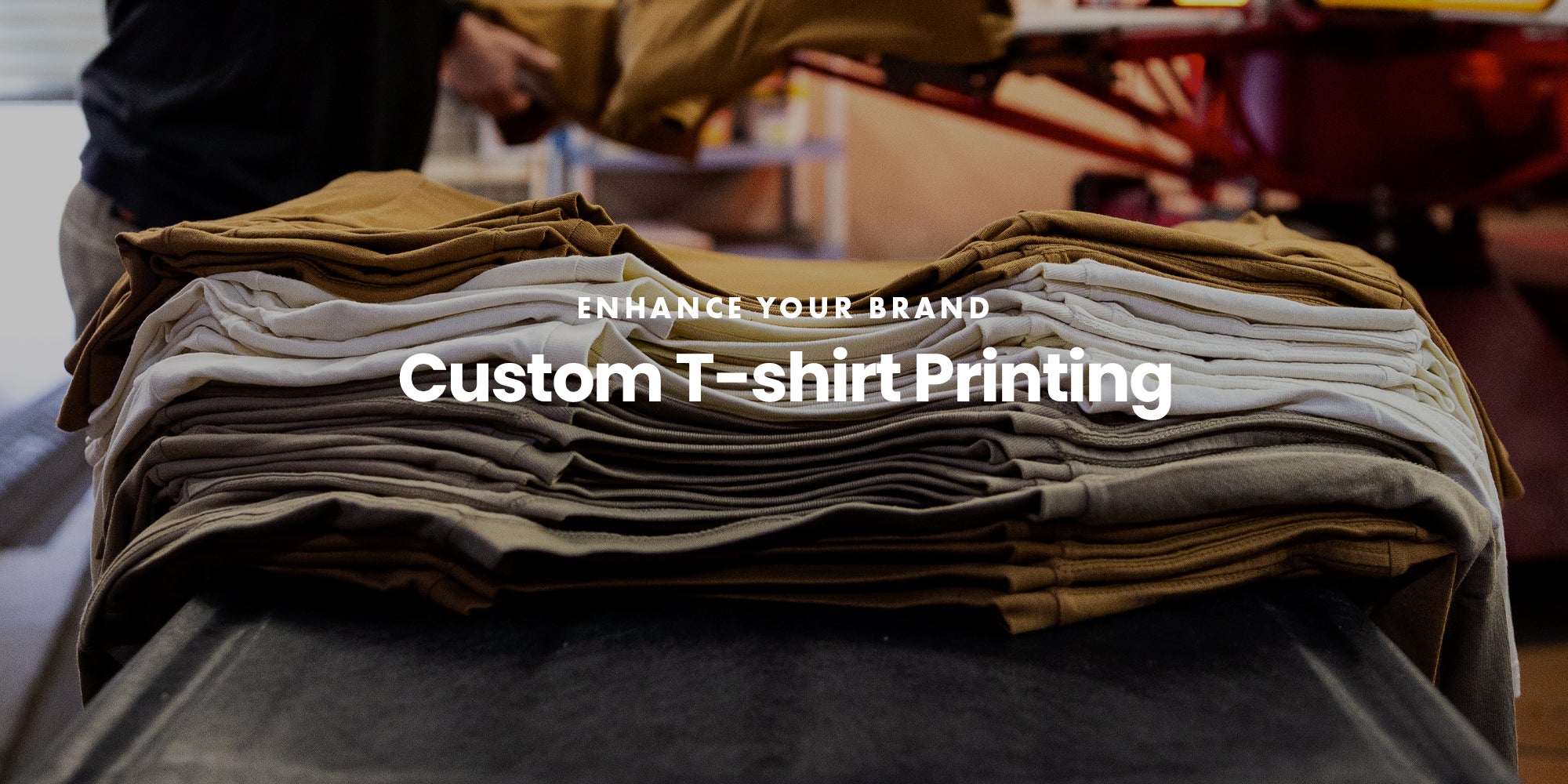Vintage Style Silk Screen Printing for Retro Fashion
Display Printing Uncovered: Everything You Need to Know Concerning T-Shirt and Garment Printing Techniques
Display printing is a remarkable method that integrates art with strategy, using unlimited possibilities for creativity. Ready to discover the vital aspects that make screen publishing an art kind?
The Essentials of Screen Printing: Exactly How It Works
When you plunge into screen printing, you'll find it's both an art and a science. At its core, display printing involves developing a pattern, or screen, that enables ink to go through only in particular areas (screen printing kit). You start by picking your layout and preparing your screen with a light-sensitive emulsion. Once you reveal this emulsion to light, it hardens, leaving your layout as a negative space.
Next, you'll blend your inks and prepare your printing surface area. Setting the display over the fabric, then use a squeegee to push ink through the screen onto the garment. This procedure needs precision, as you desire clear, vivid prints. After printing, you'll cure the ink with heat, guaranteeing it follows the textile and lasts through cleans. Each action is necessary, and understanding them will boost your screen printing abilities, changing basic garments right into one-of-a-kind, expressive pieces.
Kinds Of Screen Printing Techniques
As soon as you comprehend the fundamentals of screen printing, it's time to explore the different strategies that can elevate your designs. One popular method is standard screen printing, where ink is pressed through a stenciled display.
Another alternative is plastisol printing, understood for its sturdiness and brilliant shades, making it a preferred for many brand names. Experiment with halftone printing to develop slope impacts and elaborate designs.
Crucial Devices for Display Printing
To achieve stunning results in display printing, having the ideal devices is basic. You'll need a strong display printing structure, which holds the mesh that moves your design onto the garment. Next off, spend in top notch mops; these are crucial for using ink uniformly across the display.
Choosing the Right Inks and Products
When picking inks and products for screen printing, you require to take into account the sort of ink that works finest for your job. Consider material compatibility to guarantee your layouts look last and fantastic lengthy. Discover green ink choices to make your printing process much more sustainable.
Kinds Of Display Inks
Choosing the ideal display ink is vital for achieving vibrant, sturdy prints that satisfy your job's needs. There are several sorts of screen inks to analyze. Plastisol ink is prominent for its flexibility and convenience of usage, offering exceptional color opacity on dark fabrics. Water-based ink, on the other hand, provides a softer feeling and is green, making it excellent for those seeking to reduce their ecological effect. Release inks remove dye from the textile, causing a soft, classic look yet need certain handling. Lastly, specialized inks, such as glow-in-the-dark or metal, can include one-of-a-kind effects to your styles. Review your task needs and choose the ink that lines up ideal with your desired end result.

Textile Compatibility Considerations
Comprehending material compatibility is vital for accomplishing high-quality display prints, particularly since various materials react uniquely to numerous inks. When choosing inks, take into consideration the fabric kind-- cotton, polyester, or blends. For cotton, water-based inks function well, supplying soft qualities and breathability. Polyester, on the other hand, frequently requires plastisol inks for much better adhesion and vibrant colors. You could need to use a mix of both kinds if you're publishing on blends. Constantly examine your inks on example material to ensure they stick properly and preserve color honesty. Furthermore, bear in mind that material weight and texture can impact the last end result, so selecting the right ink and material combination is vital for your project's success.
Eco-Friendly Ink Options
Green inks are coming to be a prominent selection for screen printers that wish to reduce their environmental influence while preserving top quality. When picking inks, consider water-based inks, which are much less damaging and simpler to tidy up compared to standard solvents. These inks bond well with fabrics, providing dynamic results without toxic chemicals. You might also explore eco-solvent inks that make use of fewer volatile natural substances (VOCs), making them a more secure option for both your health and the earth.
Additionally, try to find inks made from sustainable resources, such as soy or vegetable-based choices. By picking the appropriate inks and products, you'll not just produce magnificent styles yet also add to a more lasting printing procedure. Make the button, and your prints will mirror your commitment to the atmosphere!
Preparing Your Layout for Screen Printing

Submit Style Demands
To guarantee your style looks lively and sharp on material, you'll require to pay very close attention to submit style requirements for display printing. Beginning with vector documents like AI or EPS, as they can be scaled without shedding high quality. If you make use of raster photos, go with high-resolution data, such as TIFF or PNG, ideally at 300 DPI. Prevent making use of JPEGs, as they can lose clearness when resized. Likewise, ensure your style has a clear history to avoid undesirable white sides on your prints. Lastly, maintain shade settings in mind; CMYK site link is conventional for screen printing, so transform your RGB makes accordingly. By following these guidelines, you'll establish your art work up for a successful print.
Color Separation Strategies
Shade splitting up is a crucial step in preparing your style for screen learn the facts here now printing, and mastering it can substantially boost your print quality. You'll require to break your layout into specific shades, as each color calls for a separate screen throughout printing. This precision not just guarantees exact color depiction but likewise enhances the printing process.
Resolution and Size
Accomplishing the most effective cause display printing begins with ensuring your layout has the best resolution and size. Preferably, your artwork must go to least 300 DPI (dots per inch) for sharp, clear prints. If you utilize lower resolution, your last item might look pixelated and amateur.
When it pertains to dimension, consider the dimensions of your print location. Design your artwork to match the final print dimension, preferably developing it in the actual dimensions you'll be printing. This means, you'll avoid any unforeseen scaling concerns.
Always check your style in both vector and raster styles. Vector graphics can be scaled without shedding high quality, making them excellent for screen printing. Preparing correctly will ensure your style looks fantastic on every garment!
Step-by-Step Display Printing Refine
Display printing is a vibrant process that enables you to produce dynamic layouts on numerous surface areas. To obtain begun, you'll require a display, solution, and your picked ink. Prepare your screen by cleaning it thoroughly. Next, apply the emulsion evenly and allow it dry in a dark area. Once completely dry, subject your screen to light with your style positioned on it, which will certainly solidify the emulsion where the light hits, producing a pattern - screen printing kit.
After rinsing the unexposed emulsion, your screen prepares. Set it up on your printing surface and straighten your garment under it. Put ink onto the display and utilize find out this here a squeegee to press the ink via the pattern onto the material. Lift the display carefully and allow the print completely dry. Cure the ink using heat to assure sturdiness. That's it! You've efficiently display published your style.
Tips for Successful Screen Printing Projects
While you're diving right into your screen printing tasks, bear in mind that prep work is essential to success. Beginning by collecting all your materials-- inks, displays, garments, and mops. A tidy work area assists protect against unwanted mistakes, so tidy up prior to you start.
Next, validate your artwork is high-resolution and effectively sized for your garment. Check your display for proper direct exposure and tidy it completely to stay clear of spots. When mixing your inks, comply with the manufacturer's guidelines to attain the appropriate uniformity.
Throughout printing, apply even stress with your squeegee for regular outcomes. Don't rush; take your time to validate each print meets your requirements. After printing, let your garments completely dry completely before managing or packaging them.
Last but not least, constantly keep a sample of your job for future referral. This way, you can evaluate your development and improve your strategies over time. Pleased printing!

Regularly Asked Inquiries
How Long Does It Require To Set up a Screen Printing Work?
Establishing a screen printing work typically takes around 30 mins to an hour. You'll prepare the displays, mix inks, and adjust the press. The moment differs based on intricacy and experience, so stay arranged!
Can I Publish on Various Material Keys In Utilizing the Exact Same Technique?
Yes, you can print on various textile types using the very same method, but you'll require to readjust your inks and setups. Some textiles take in ink in a different way, so experimenting guarantees the very best outcomes for each product.
What Prevail Blunders to Prevent in Screen Printing?
When display printing, avoid usual mistakes like making use of the wrong ink, overlooking correct exposure times, or skipping pre-press checks. Always examine your configuration and maintain tidy displays to guarantee high quality results each time.
How Can I Effectively Clean and Keep My Display Printing Equipment?
To effectively clean and keep your display printing equipment, you should routinely clean screens with proper solvents, inspect squeegees for wear, and ensure all devices are stored dust-free and dry. Consistency enhances and stops costly repair work efficiency.
Is Screen Printing Ecologically Pleasant Compared to Other Approaches?
Screen printing can be much more ecologically pleasant than other methods, especially if you utilize eco-conscious materials and water-based inks. By selecting lasting products and practices, you decrease waste and reduce your effect on the earth.
Screen Printing Uncovered: Everything You Need to Know Regarding Tee Shirt and Garment Printing Strategies
At its core, screen printing involves creating a stencil, or screen, that enables ink to pass via only in details locations. Placement the display over the textile, after that make use of a squeegee to push ink through the screen onto the garment. One preferred method is conventional screen printing, where ink is pushed with a stenciled screen.When selecting inks and materials for screen printing, you need to take into account the type of ink that works best for your project.